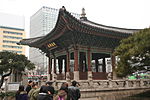Gwanghwamun station
Metro stations in Jongno DistrictRailway stations opened in 1996Seoul Metropolitan Subway stations

Gwanghwamun Station is a station on the Seoul Subway Line 5 in South Korea. It is not the closest subway station to the actual gate of Gwanghwamun, which it is named after. It is located next to the U.S. Embassy in Seoul. This station boasts the most traffic of all Line 5 stations.
Excerpt from the Wikipedia article Gwanghwamun station (License: CC BY-SA 3.0, Authors, Images).Gwanghwamun station
Gwanghwamun Square, Seoul
Geographical coordinates (GPS) Address Nearby Places Show on map
Geographical coordinates (GPS)
| Latitude | Longitude |
|---|---|
| N 37.571583333333 ° | E 126.97658333333 ° |
Address
광화문
Gwanghwamun Square
03154 Seoul
South Korea
Open on Google Maps





